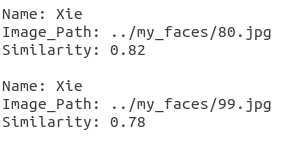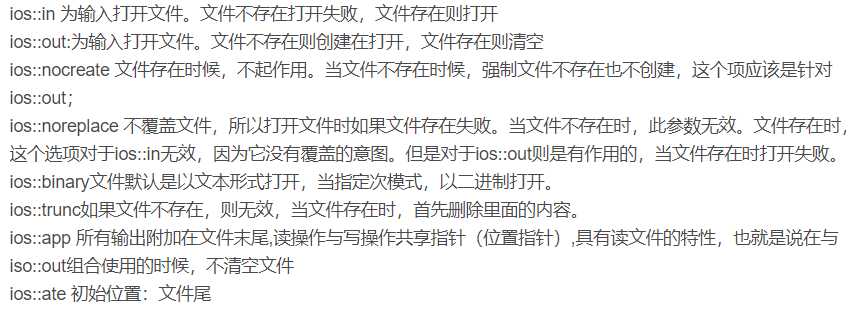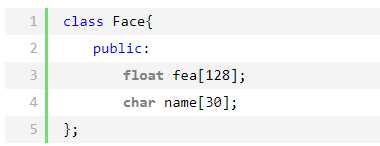标签:函数 clock printf files cos getline http 数据格式 null
在此之前我已经分别使用过这两种方法,我这里没有重新写代码,只po上我之前实际使用的
头文件都是<fstream>
方法一:


方法二:
fstream pos("./pos_scores.txt", fstream::in | fstream::out | fstream::trunc);
...
pos << pair_id <<"\t"<< cal << "\t" <<pos_left<<"\t"<<pos_right<<endl;
头文件都是<fstream>两种方法应该是接近一样的,所以我去网上找了更好的总结
博客一:C++中简单的文本文件输入/输出 入门首选,但读写的格式类型比较简单了,稍微复杂一点就需要用结构体
博客二:C/C++读写文本文件、二进制文件 我的第一个读写二进制文件写法就抄的这里,我觉得c++的写法更简洁,所以我会将c++的例子搬过来
文本读:

//采用CPP模式读取txt
void TextRead_CPPmode()
{
fstream f;
f.open("txt_out.txt",ios::in);
//文件打开方式选项:
// ios::in = 0x01, //供读,文件不存在则创建(ifstream默认的打开方式)
// ios::out = 0x02, //供写,文件不存在则创建,若文件已存在则清空原内容(ofstream默认的打开方式)
// ios::ate = 0x04, //文件打开时,指针在文件最后。可改变指针的位置,常和in、out联合使用
// ios::app = 0x08, //供写,文件不存在则创建,若文件已存在则在原文件内容后写入新的内容,指针位置总在最后
// ios::trunc = 0x10, //在读写前先将文件长度截断为0(默认)
// ios::nocreate = 0x20, //文件不存在时产生错误,常和in或app联合使用
// ios::noreplace = 0x40, //文件存在时产生错误,常和out联合使用
// ios::binary = 0x80 //二进制格式文件
vector<int> index;
vector<double> x_pos;
vector<double> y_pos;
if(!f)
{
cout << "打开文件出错" << endl;
return;
}
cout<<"mode为1,按字符读入并输出;mode为2,按行读入输出;mode为3,知道数据格式,按行读入并输出"<<endl;
int mode = 1;
cin>>mode;
if(1== mode)
{
//按字节读入并输出
char ch;
while(EOF != (ch= f.get()))
cout << ch;
}
else if(2 == mode)
{
//按行读取,并显示
char line[128];
int numBytes;
f.getline(line,128);
cout << line << "\t" << endl ;
f.getline(line,128);
cout << line << "\t" << endl ;
f.seekg(0,0); //跳过字节
//seekg(绝对位置); //绝对移动, //输入流操作
//seekg(相对位置,参照位置); //相对操作
//tellg(); //返回当前指针位置
while(!f.eof())
{
//使用eof()函数检测文件是否读结束
f.getline(line,128);
numBytes = f.gcount(); //使用gcount()获得实际读取的字节数
cout << line << "\t" << numBytes << "字节" << endl ;
}
}
else if(3 == mode)
{
//如果知道数据格式,可以直接用>>读入
int index_temp = 0;
double x_pos_temp = 0, y_pos_temp = 0;
while(!f.eof())
{
f >> index_temp >> x_pos_temp >> y_pos_temp ;
index.push_back(index_temp);
x_pos.push_back(x_pos_temp);
y_pos.push_back(y_pos_temp);
cout << index_temp << "\t" << x_pos_temp << "\t" << y_pos_temp << endl;
}
}
f.close();
}
文本写:

//采用CPP模式写txt
void TxtWrite_CPPmode()
{
//准备数据
int index[50] ;
double x_pos[50], y_pos[50];
for(int i = 0; i < 50; i ++ )
{
index[i] = i;
x_pos[i] = rand()%1000 * 0.01 ;
y_pos[i] = rand()%2000 * 0.01;
}
//写出txt
fstream f("txt_out.txt", ios::out);
if(f.bad())
{
cout << "打开文件出错" << endl;
return;
}
for(int i = 0; i < 50; i++)
f << setw(5) << index[i] << "\t" << setw(10) << x_pos[i] <<"\t" <<setw(10)<< y_pos[i] << endl;
f.close();
}
二进制读:

//采用CPP模式读二进制文件
void DataRead_CPPMode()
{
double pos[200];
ifstream f("binary.dat", ios::binary);
if(!f)
{
cout << "读取文件失败" <<endl;
return;
}
f.read((char*)pos,200*sizeof(double));
for(int i = 0; i < 200; i++)
cout << pos[i] <<endl;
f.close();
}
二进制写:

//采用CPP模式写二进制文件
void DataWrite_CPPMode()
{
//准备数据
double pos[200];
for(int i = 0; i < 200; i ++ )
pos[i] = i ;
//写出数据
ofstream f("binary.dat",ios::binary);
if(!f)
{
cout << "创建文件失败" <<endl;
return;
}
f.write((char*)pos, 200*sizeof(double)); //fwrite以char *的方式进行写出,做一个转化
f.close();
}
博客三:fstream文件打开模式 使用上面四个代码的格式,需要指定文件打开模式

博客四:c++ 二进制文件读写 这篇是我之前写的博客,那时要格式化的读写二进制文件,这个是留着我自己看的(因为我写了几篇c++读写的博客,以后我打算只看这篇了)

读取图片保存至binary.dat二进制文件

//write binary.dat void img2dat(){ struct dirent *ptr, *ptr1; DIR *dir, *dir1; dir = opendir("../lfw_crop/"); string file_path, temp; std::vector<Anchor> result_copy; int num = 0,count = 1; ofstream outFile("binary.dat", ios::out | ios::binary); Face face_temp[6000]; // printf("lists of files:\n"); while((ptr = readdir(dir)) != NULL){ if(ptr->d_name[0] == ‘.‘) continue; //search subdirectory char sub_dir[50] = "../lfw_crop/"; strcpy(face_temp[num].name, ptr->d_name); strcat(sub_dir, ptr->d_name); file_path = sub_dir; dir1 = opendir(sub_dir); while((ptr1 = readdir(dir1)) != NULL){ if(ptr1->d_name[0] == ‘.‘) continue; temp = ptr1->d_name; file_path = file_path + "/" + temp; cv::Mat img = imread(file_path); count = 1; cout<<temp<<endl; Mat face = mt(img, result_copy, count); if (count){ fea = extract_feature(face); for(int i=0;i<128;i++) face_temp[num].fea[i] = fea[i]; outFile.write((char*)&face_temp[num], sizeof(face_temp[num])); cout<<++num<<endl; } //just one img break; } closedir(dir1); } closedir(dir); outFile.close(); }
读binary.dat并进行特征比对

if(count) { clock_t start_2, finish_2; start_2 = clock(); vector<float> feature2 = extract_feature(face2); finish_2 = clock(); cout << "mobilefacenet cost " << (float)(finish_2 - start_2) / CLOCKS_PER_SEC * 1000 << " ms" << endl; //2019.6.12 int i=0, num=0; double curcal, max=0; string forecast_name; //2019.6.17 // float fea[128]; string name; clock_t start_3, finish_3; start_3 = clock(); Face face_temp[6000]; while(inFile.read((char *)&face_temp[num], sizeof(face_temp[num]))){ curcal = calculSimilar(feature2, face_temp[num].fea); if(curcal > max){ max = curcal; forecast_name = face_temp[num].name; } } finish_3 = clock(); cout << "search binary.dat cost & calculSimilar:" << (float)(finish_3 - start_3) / CLOCKS_PER_SEC * 1000 << " ms" << endl; cout << "max similarity is: "<< max << endl; cout << "forecast name is: "<< forecast_name <<endl <<endl; }
标签:函数 clock printf files cos getline http 数据格式 null
原文地址:https://www.cnblogs.com/exciting/p/11165535.html